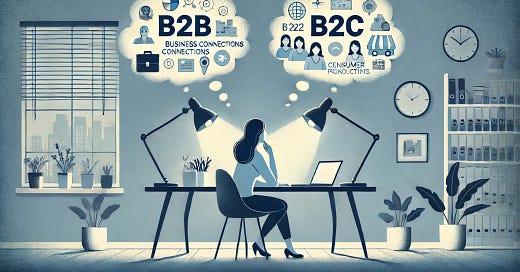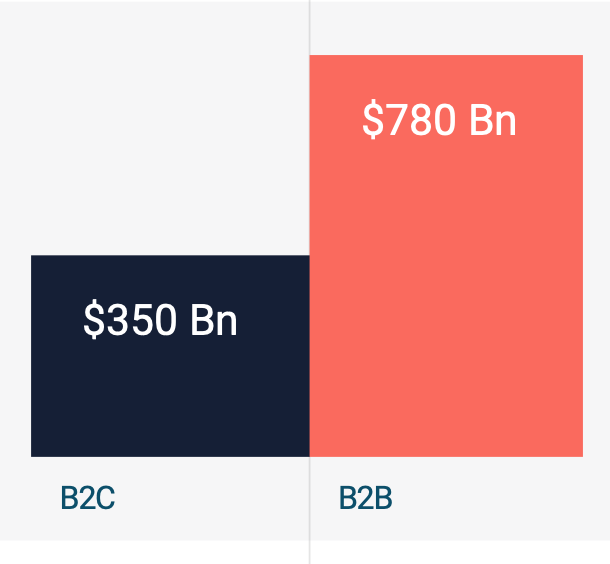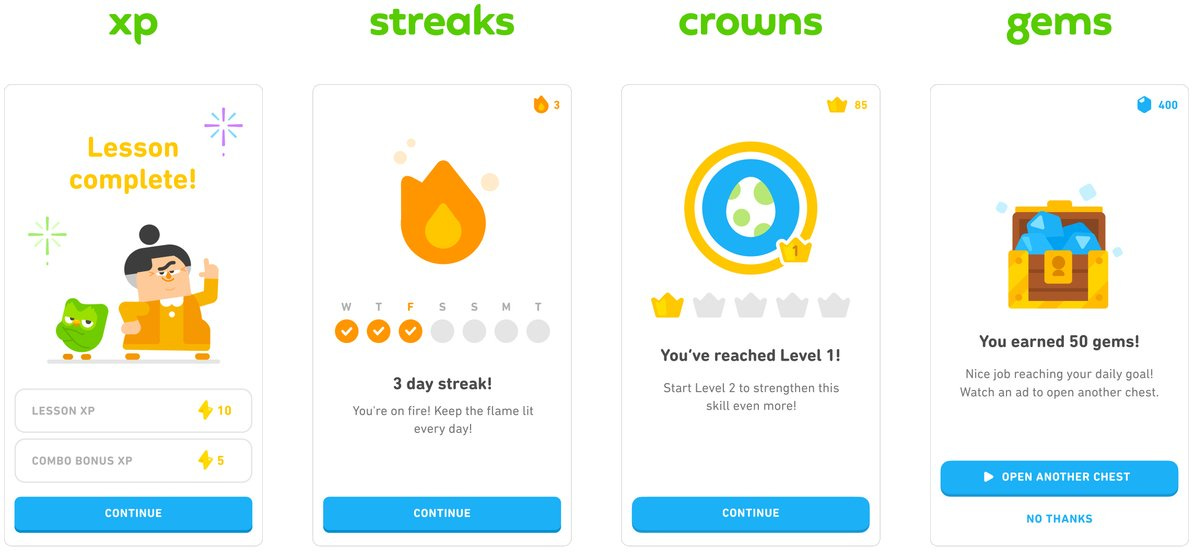The B2B vs. B2C Dilemma: Why Building a Consumer Startup Is Harder (and January's Must-Attend Events)
Why do so many founders dream of building the next Airbnb, Netflix, or TikTok? The allure of B2C is undeniable—direct impact, massive markets, and the chance for viral growth. Yet, the reality is stark: B2C startups are much harder to build and sustain.
Venture capital funding trends reflect this reality: approximately 70% of venture funding flows to B2B (Business-to-Business) companies, leaving just 30% for B2C startups. The B2C market size (~$350 billion) also pales in comparison to B2B’s $780 billion market, where customers spend more and churn less. Even iconic consumer-facing companies like Amazon and Google derive most of their profits from B2B operations (e.g., AWS, Google Cloud, search advertising).
The rise of GenAI has only widened the gap. While AI is transforming both B2B and B2C, its impact is particularly profound in B2B. Let’s unpack why this is the case—and what aspiring founders can learn from these trends.
Source: Why B2B vs B2C
Why Founders Love B2C
Massive Market Potential: Billions of consumers are out there waiting.
Direct Impact: Founders see their products improving people’s daily lives.
Chance for Viral Growth: Great products can scale quickly through word-of-mouth and network effects.
Steep Defensive Moat: Once the branding and network effects are built, it becomes challenging for competitors to disrupt.
But for every breakout success like Airbnb, thousands of B2C startups fail to make it past the early stages. Why?
The Reality Check: Why B2C Is Tougher
Sky-High Customer Acquisition Costs: Getting consumers’ attention can be prohibitively expensive, especially with constant competition on social media. Acquiring even a single user through Google Ads or Facebook Ads can cost $5–$9.
Low Switching Costs: With lower ticket sizes, B2C customers can easily jump ship for a cheaper or trendier alternative, forcing near-constant innovation and updates.
Winner Takes All Phenomenon: In many consumer markets, one or two major players dominate, leaving newcomers to fight for smaller slices of the market. Platforms like TikTok or Instagram grow so large so fast that it’s tough for emerging competitors to carve out meaningful space.
Cold Start Problem for Marketplaces: Models like Airbnb rely on both buyers and sellers. Without enough hosts, guests won’t book; without enough guests, hosts won’t join.
Operational Complexity: Serving millions of users requires robust tech, strong customer support, and seamless logistics—no small feat.
Long Timelines to Achieve Product-Market Fit: Airbnb spent about three years before it truly took off in 2011. Spotify spent four years negotiating licensing deals and cultivating a loyal listener base. TikTok refined its product and recommendation algorithm for four years before achieving exponential growth by 2018.
Why GenAI Has Widened the Gap
GenAI has been game-changing for both B2B and B2C, yet it tends to give B2B a bigger advantage. Large, structured datasets—such as sales metrics or customer analytics—are perfectly suited for AI models that deliver immediate, measurable ROI.
B2B solutions (e.g., Salesforce’s Einstein GPT, OpenAI’s Codex) seamlessly integrate into enterprise workflows, analyzing trends, predicting outcomes, and optimizing processes. AI-powered automation reduces manual tasks (like drafting contracts or suggesting product tweaks) while offering actionable insights on resource allocation and client prioritization. Crucially, enterprise AI deepens client relationships by predicting needs and crafting hyper-personalized solutions, cutting churn and attracting investor attention.
In contrast, while B2C AI (like recommendation engines or chatbots) can enhance personalization and content generation, monetizing these features amid stiff competition and high user churn is far more difficult. Privacy concerns and fragmented data further hamper deep personalization for consumer markets, expanding the funding gap between B2B and B2C.
If You Still Want to Build B2C, Here’s How to Win
Despite these challenges, many B2C startups succeed by honing in on core strategies:
1. Create Products People Can’t Live Without
The most successful B2C products solve a real pain point and become indispensable. Your product must be a “painkiller,” not just a “vitamin,” and it should integrate seamlessly into users’ routines.
Example: Duolingo revolutionized language learning by gamifying lessons, making them fun, addictive, and part of users’ daily habits—ultimately amassing hundreds of millions of downloads.
2. Build Communities, Not Just Products
Emotional bonds turn customers into advocates who spread the word. Get your audience involved early to establish genuine loyalty.
Example: Glossier co-creates products with its community, encouraging fans to shape and promote the brand. Peloton offers more than just exercise equipment; it fosters a community of riders who motivate each other, resulting in powerful network effects and high retention.
3. Leverage Niche Verticals for Focused Impact
A specialized audience helps your offering stand out. Start small, dominate a niche, and then scale methodically.
Example: Plantstory caters to plant enthusiasts by offering personalized care tips and fostering a hobbyist community, driving deep engagement before expanding features.
Source: Agora
4. Master the Art of Viral Growth
Virality can slash CAC and trigger exponential scaling. Incorporate social sharing and network effects from day one to amplify organic growth.
Example: Houseparty rapidly expanded via group video chats that encouraged friends to invite more friends, creating a viral loop of user engagement. TikTok’s “For You” feed fuels user-generated sharing, creating a viral content loop.
5. Focus on Retention Over Acquisition
Retaining users boosts revenue and maximizes Customer Lifetime Value. Don’t just chase new downloads—work to keep current users engaged and satisfied.
Example: Spotify charms listeners with curated playlists like “Discover Weekly,” making each return session feel fresh. Netflix constantly invests in original content and personalized recommendations, giving subscribers fresh reasons to stay month after month.
6. Prioritize Product Over Marketing
A great product with a seamless user experience will drive organic growth. Heavy marketing can’t fix a subpar offering.
Example: Patreon grew through genuine value—letting creators monetize fan support directly—rather than flashy ad campaigns, sustaining long-term loyalty.
B2C success stories—like Airbnb, TikTok, and Spotify—prove that consumer-focused companies can still break boundaries and transform entire industries. But high CAC, steep competition, and long paths to adoption are real obstacles. Meanwhile, generative AI often boosts B2B’s advantage, making the consumer startup journey even more challenging.
Still, with a can’t-live-without-it product, a vibrant community, and a careful approach to retention and funding, B2C founders can defy the odds and carve out new markets. It’s far from easy, but for those who succeed, the rewards can be truly world-changing.
Upcoming January Events
⚡ Dinner with #GenAI Pioneers: Discuss AI applications, cutting-edge technologies, and future trends with founders leading AI efforts in Google, OpenAI, Nebius and Centauri AI. (Fri, 1/10 6-8 pm, Mountain View), RSVP here
🗓 AI & B2B SMB/Enterprise Tech: Insights from Executive VPs from Hubspot, Informatica, Turing and Indeed (Sat, 1/25 3-5 pm, Mountain View). Early-bird tickets on sale, RSVP here
🌟 Founders Spotlight: Showcase Your Startup at our Virtual Demo Day. Founder-focused event that is open to founders who want to showcase to investors or connect with early customers. Submit your application Here by 1/15.












